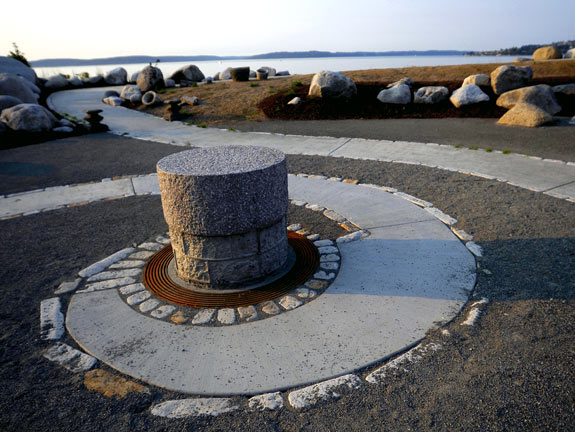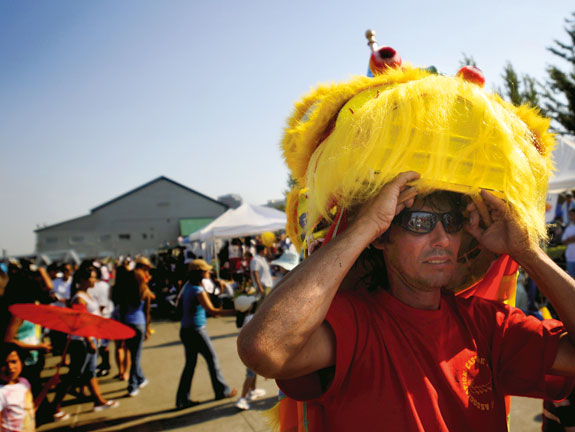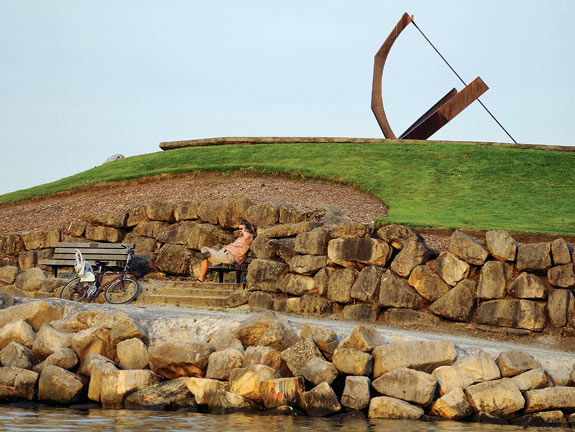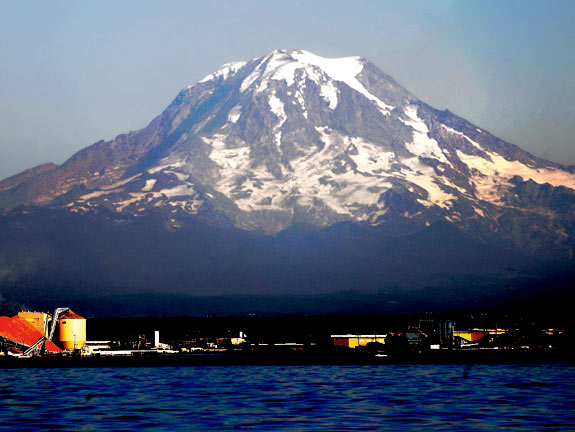Lara Herrmann is a personal injury lawyer with a busy practice. She’s also a new mother balancing her work and family. Still, she has spent the past year thinking about Tacoma’s history and ecology, and its tideflats and toxins. Whether she’s working on a case or walking her baby in a stroller, in the back of her mind she’s mulling a plan to protect her city’s seven-mile waterfront.
Herrmann ’95 and a group of friends and neighbors are intent on righting the city’s historical wrongs, helping finish the clean-up of some of its most polluted sites, protecting precious salmon habitat, and connecting the community with one of its greatest natural assets.
Photos by Ingrid Barrentine
The great notion, which she shares with a grassroots group called Walk the Waterfront, is to complete a pedestrian path that would wind along the south shore of Commencement Bay from the Tacoma Dome past downtown and the adjoining historic neighborhood and all the way north and west out to the vibrant, verdant 700-acre public treasure known as Point Defiance Park. Such a path would bring more people to the waterfront to socialize, exercise, enjoy the scenery, learn some history, and visit small businesses scattered along the way.
It would also pass through and maybe revive some of the city’s oldest and most derelict industrial sites, says Herrmann. We talk about this over coffee one morning this summer in the warm café at the Spar, Tacoma’s oldest operating saloon. We’re in the Old Town neighborhood just two blocks up from Ruston Way, the part of the waterfront that gets the most public use. The sun and seagulls are out, and the air smells of salt.
The two-mile segment below us has parks, public piers and docks, restaurants, a hotel, and a long promenade that skirts the turquoise water’s edge. It’s what Herrmann envisions for the whole seven miles. But there is still Tacoma’s industrial past to overcome, she says. The rest of the route east to downtown is blocked by industrial uses as well as by Schuster Parkway, a busy automotive bypass. Go too far in the other direction and you run smack into the Asarco smelter site, which has left Tacoma with several million tons of toxic waste.
While she is describing the waterfront’s history and pointing out its views of Mount Rainier and the Olympics, Herrmann has an inspiration. “You have to see this,” she says as she rushes us out to her Prius and whisks us several blocks up the hill through Old Town Tacoma, where the city’s first homesteads were built in the late 1800s. We stop in a manicured neighborhood of old and newly-remodeled homes. A large stone perches in the grass on one corner.
Herrmann waves me over to the monument and we lean forward to read the plaque. “I was amazed when I first saw this,” she says of the text composed by the Women’s Club of the Washington State Historical Society in 1920. It says that just 600 feet to the east of the stone was the Tacoma Mill, built in 1868 on a site called the “Che-bau-lip.” “I think that means ‘shelter place,'” says Herrmann letting her finger land on the word. Besides being one of the first lumber mills in the community, could it also be that this was a special place for the Puyallup and Nisqually tribes? There’s no other marker or really any official acknowledgement that this was once a place used by them, she says. “I wonder; are we losing this piece of our history?”
When Tacoma was still not much more than a cluster of houses and mills, it was dubbed “The City of Destiny,” an optimistic moniker for its potential to be the center of business on the Sound. True, over the years Tacoma has had a place in the sun. At one point it was the fastest-growing community between Portland and Canada. But too often it has slipped back into the shadows while its residents struggled with economic downturns, crime, pollution, and trying to be more than just another one of Seattle’s suburbs.
It is a town with many facets, a blend of assets and neglect, a former railroad hub, industrial seaport, and with Fort Lewis and McChord Air Force Base, a military center. Tacoma is in constant search of the right identity, according to historian Murray Morgan, who was born and raised there. In his book Puget’s Sound he wrote that “the City of Destiny remains unsure of what its destiny should be.”
But there are so many things it is and could be, says Herrmann. Tacoma’s inhabitants just have to recognize and use what they have. “There’s so much more to this area than what we know right now.”
TACOMA DISCOVERY
In the spring of 1792 the British sloop the H.M.S. Discovery sailed into the Puget Sound and dropped anchor just off Bainbridge Island. From this harbor, the crew took expeditions in small boats to explore and map the shoreline around the sound. When, about 28 miles south, they neared the Dalco Passage, they were the first non-Indians to admire what would become Tacoma’s waterfront. They noted the stunning aspect up the shoreline to a snow-capped mountain. In their diaries, Vancouver and several of his crew remarked on the area’s beauty, the abundant woodlands, and the serene climate.
But that wasn’t enough to lure pioneers. Because of the remoteness and the availability of fur and food in other places, the first settlers didn’t arrive until 1864 when Job Carr filed a claim for 168 acres along the waterfront of what would become Old Tacoma. The area then started to draw residents of European extraction.
Soon others, including Carr’s sons, bought up and platted the land and started clearing the dense timber to build a town. In 1873 Tacoma beat Seattle and Olympia to win Northern Pacific Railway’s Puget Sound terminus. By the 1870s, Tacoma was a lively and growing metropolis, the center of the Sound. Anyone intending to travel between Portland, Olympia, Seattle, and Victoria had to pass through Tacoma where they would catch a steamboat or a train. Because of the wooded, hilly landscape around the Sound, what few roads there were could at times be impassible.
So Tacoma owes its existence to its waterfront. Its bay, a rare deep saltwater harbor, was ideal for a shipping-based economy. A hub for transportation, it also drew industry–fishing, logging, and boat building. In 1877, the city adopted a plan that filled the waterfront with railroad tracks, yards, and wharfs. By the 1890s warehouses, lumber mills, tall ships, and steamboats lined the shoreline. Tacoma was the state’s key port for shipping eastern Washington wheat and western Washington hops, coal, and lumber, as well as for receiving goods from Asia including tea, silk, and rice.
The tideflats at the south end of the bay were filled in and channelized to create eight waterways, including the Thea Foss, which is closest to the city and named for a Norwegian immigrant who started a tugboat business on the bay. Foss, a savvy businesswoman, was the basis for the MGM movie character “Tugboat Annie.”
For a few decades, Tacoma was the star of the Sound. Its downtown was a jewelry box of beautiful buildings including the Italianate-style Northern Pacific Building, built in the 1880s, and the 1893 brick and terra cotta City Hall.
Then in the mid 1890s, everything fell apart. As the nation sunk into an economic depression many of the city’s banks and businesses closed. By the end of it, the railroad had moved its hub to Seattle.
In the wake of losing its railroad focus, Tacoma turned to enhancing its industry along the water, which included shipbuilding, lumber, pulp and paper mills, oil refining, and chemical manufacturing and storage. There was a coal gasification plant and later an automotive recycling business. Construction pushed up the shoreline to the 67-acre site of the Asarco copper smelter.
While all these businesses brought jobs and money to Tacoma, they also contributed to the tars, acid, and other toxins along and in the water. By the 1980s, a century of heavy industry had made Tacoma an ecological disaster. In 1983 the 12 square miles of Commencement Bay were declared a federal Superfund site,
one of the most polluted waterways in the country. At one end, the Asarco smelter had over the decades deposited 15 million tons of slag byproducts, including arsenic, cadmium, and lead, next to and into the Sound. At the other, the waterways’ businesses had done their own share of polluting.
In the years since then, the government has made efforts to hold the polluters accountable and well over $100 million has been spent to clean up Tacoma’s waterways. Because of the oversight and involvement of local government and the Federal Environmental Protection Agency, Lara Herrmann hadn’t thought much about the industrial site below her home until one night last year when she got up to feed her baby and realized her house was flooded with light. The source was a dock and two hulking military support ships just below the cliff that forms one side of her neighborhood. Herrmann started thinking more about it when she heard that the dock’s owner was requesting permits to add two more ships. Just by looking over the hillside, she could tell much of the large dock had rotted and collapsed. With the exception of a built-up area along one side, it was unusable. And considering the noise, the light, and the black smoke that comes from the ships, Herrmann couldn’t imagine that site would be allowed to expand.
“Of course my city, my government wouldn’t allow two more super mega structures right along the waterfront, right next to a salmon habitat, perched between two schools and two parks,” she says. “But I was wrong.” At a public hearing, Herrmann discovered that the council didn’t have much to say in the matter, the area was zoned properly, and it was a “quasi-judicial,” issue, she says. “I was so shocked. I realized if our community does not stand up and say enough, we’re going to have a military shipyard right here on our working waterfront.”
As Herrmann came to understand that the city couldn’t stop the expansion in an area zoned for industrial use, her mission became clear. Tacoma has this great resource with its urban waterfront, she says, but it needs to be expanded and revitalized. It needs uses that are compatible with its urban and residential neighborhoods, as well as with the fragile ecology along the shoreline.
A grassroots group of Tacoma residents started meeting last fall to plan a campaign to unify and revitalize the waterfront. They settled on a catchy name “Walk the Waterfront,” and began looking at other cities with waterfront issues. “Everything we’re doing, none of it is original,” says Herrmann, who is now president of the nonprofit organization.
The idea of using open space to revitalize cities has been around since the ’60s, says Jeffrey Sanders, an assistant professor in history at Washington State University. Sanders, who specializes in environmental and Pacific Northwest History, remembers driving along the Tacoma waterfront during his childhood in the 1970s and being shocked when the car went by the Asarco site. “I was blown away by the strange mixture of denuded landscape with what seemed to be a really beautiful scenic drive.”
What’s happening now in Tacoma makes sense, he says, especially with individuals from within the community pushing for more public space. It’s now more democratic, with community groups and grassroots organizations helping the city decide how and where public spaces should develop, he says. The challenge is making sure all the voices, including those of lower income residents, are heard. “I’m all for revitalization … but you always have to ask the question, who is benefitting and who isn’t from these changes,” he says.
The Ruston Way portion of the waterfront draws residents from all over the city. That is a source of pride for Herrmann and her cohorts. On the weekday we visited, the path and parks were bustling. A large Russian family was out for a walk, a group of teens clustered under a tree to check out a friend’s new guitar, and an older man rode by on a bicycle with a little boy, likely his grandson, perched sideways on the back. “This is our Central Park,” says Herrmann.
DRAWING ON THE PAST
Twenty years ago, the City Club of Tacoma approached the city with a plan to unify the waterfront and build a walking path from the Tacoma Dome to Point Defiance. The club is a non-partisan, nonprofit organization. The painstakingly-researched report urged that the entire waterfront be redesigned as a people place–where the general public, rather than industry or business, is the primary component of the site. It even suggested rezoning the east size of the City Waterway from 15th Street from port industrial and terminal use to mixed public and private use.
Herrmann was thrilled when a city hall worker handed her the document. “It was like a present just lands in your lap,” she says. “I had it in my hands and I’m going ‘Are you kidding me? This work is already done.'” Though it’s two decades old, much of it is still relevant, says Herrmann.
But, whether the issue was money, land use, or property rights, the plan was never fully pursued, nor were plans from decades earlier. As early as the 1940s, the city was trying to preserve the waterfront. It had plans to make some of the unused industrial sites into parks and recreation areas. In 1965, another city recreation and open space plan provided for the city to buy up shore-side properties for future public use.
Still, a polluted, dangerous waterfront greeted Phyllis Harrison when she returned to Tacoma in 1988 to work on a maritime folk life project. After graduating from WSU in 1973, Harrison had gone on to earn a doctorate in folklore. Now she was coming home. With grants from the National Endowment for the Arts and the Institute of the North American West, she and a fisherman/boat builder named Mike Vlahovich had the mission of creating a traveling exhibit that would capture and preserve the culture of living and working on the water. “It was not just the history, but what was happening right then–predicting the weather, boat building, longshoring, and all the layers of tradition that went into them,” she says.
The project was a particularly good fit for Tacoma with its maritime roots, says Harrison. “Tacoma was the capital of wooden boat building and repair in this area for a long time,” she says. The exhibit was also extremely popular, taking up residence at Sea-Tac Airport for a number of years. In 1995 it found a permanent home on Tacoma’s waterfront when the city agreed to lease out part of the Puget Sound Freight building on the Thea Foss Waterway. The site was no beauty, says Harrison. In fact, it had a squatter in residence, the toilets (which couldn’t be used) emptied into the Sound, and half of the building was space for police-seized vehicles. It was a seedy sight. On the other hand, it was right on the water, says Harrison, the perfect location for a maritime museum.
Their timing was ideal. The cleanup of the Foss waterway had started, and plans were underway for a new, improved waterfront next to downtown. It paved the way for the now world-famous Museum of Glass, and a small collection of tony condominiums–with water and mountain views. But, says Harrison with pride, the very first thing to happen on the waterfront was the Working Waterfront Maritime Museum. Harrison remembers the day she learned their project would work: “It was so exciting to know that finally there was a public space where people could start coming and learning about the waterway.”
Prior Tacoma city councils have made many investments in protecting the waterfront, and providing for safe public access to the Thea Foss Waterway, which is closest to downtown, says Tacoma City Councilman Jake Fey, who also works at Washington State University as director of the cooperative extension energy program.
“We really have an asset that’s unique and attractive to people,” he says. How the council and community take advantage of that and also use the space in the best way is the real challenge.
When Fey first ran for city council in 1995, he knew he was vying for one of the larger and more complex districts in the city. His territory includes the port, downtown, several business districts, historic neighborhoods, a suburban hillside, and the waterfront. He admits the size, variety, and demands of the district can sometimes be overwhelming. But he’s also inspired by the interest and involvement of constituents like Herrmann. “Tacoma is a city, but it’s not so big that individuals can’t rise to the occasion and make a difference,” he says.
IT’S NOT THAT THE CITY OF TACOMA doesn’t have a plan for the waterfront, says Herrmann. Actually it has many, including a shoreline plan, a waterfront trail plan, a Ruston Way plan, and a Foss Waterway plan. But they are piecemeal. “We need a plan that captures the entire waterfront, the owners, and the users who should have a voice,” she says. “We can create something so spectacular that it would transform Tacoma.”
And tying it into the city’s history may be the key to getting it done. Herrmann’s interest in local history started when she was a student at Tacoma Community College and wondered why the city didn’t have a Chinatown when Seattle and Portland both did. In researching a paper, she learned that Tacoma once did have a thriving Chinese community. There was a neighborhood right on the waterfront called Little Canton that was filled with homes and businesses.
But during the economic downturn of the 1890s, after the railroad had been built, a mob led by Tacoma’s leaders and business owners drove the Chinese residents out. Little Canton was burned to the ground. The brutal expulsion, later referred to as “The Tacoma Method,” is a real stain on the community’s past, says Herrmann. In recent years, the city has tried to make amends, by formally apologizing for the expulsion as well as dedicating a Chinese Reconciliation Park at the water’s edge just outside of downtown.
The park is a great fit for the waterfront, says Herrmann. It has purpose and meaning and it is something that the community can use freely. That success has her thinking about the word “Che-bau-lip” and the Native American history in the area. At this point, Herrmann knows there are several spellings as well as explanations, a key one being that it is an Indian name of an area near the waterfront where the land slopes into the sound and where Job Carr built his cabin, the first structure in Old Tacoma. Many of the early settlers, including Carr, used the name for that location. According to historian Murray Morgan, a site below what is now the Stadium Way cliff had an Indian burial canoe and a boulder marked with petroglyphs, both now long-gone.
Members of the Puyallup tribe confirm the uses, noting that Indian history and legacy with this part of Tacoma have indeed at times been overloooked. Part of downtown, for example, was a village site, says tribal historian Judy Wright.
That’s one more component of the waterfront that should be remembered, says Herrmann.
Considering urban waterfronts around the world, Herrmann wondered what characteristics Tacoma has that “makes our waterfront even better than your waterfront?” Well that’s easy, she says. Besides the rich history specific to Tacoma, you have Mount Rainier. “You can’t see Mount Rainier from Seattle’s waterfront,” she says. And on the other end, Point Defiance Park, a spectacular tree-covered park with trails, beaches, boat launches, museums, and even a zoo. “It’s one of the best city parks in the country,” says Herrmann.
In between, there’s the cleaned-up Thea Foss Waterway, the Maritime Museum, a Chinese Reconciliation Park, the original Job Carr settlement, the Tahoma salt marsh, and a long stretch of parks and paths in front of Old Tacoma.
The city needs this new generation of citizens to care about the watefront, says Harrison. “And the waterfront needs to be a resource not only for heritage reasons,” she adds, “but also because people should not spend all of their lives with their feet on concrete, especially if they live on the shores of Puget Sound.”
Web exclusives:
An interactive photo gallery map
View photographer Ingrid Barrentine’s images along the Tacoma waterfront.
On the Web:
{a title=”Tacoma Waterfront video – TNT” href=”http://www.thenewstribune.com/959/story/380787.html”}Watch a video about the waterfront by the Tacoma News Tribune’s multimedia expert Joe Barrentine ’06.











